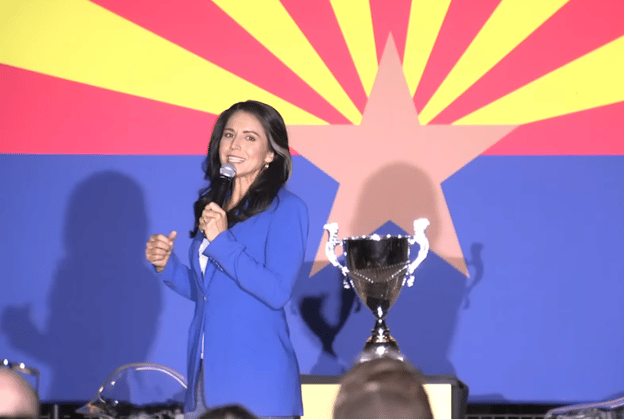
On polls taken up to Oct. 17, Arizona Republican nominee for Governor Kari Lake was leading her opponent Katie Hobbs by 3 and 4 points respectively in Daily Wire/Trafalgar and Data for Progress polls. And then she got the endorsement of former Democratic U.S. Rep. Tulsi Gabbard of Hawaii, fresh off leaving the Democratic Party, on Oct. 18 in a Twitter post.
“For too long, establishment leaders from both parties have sought to enrich themselves, play games, and build up their power while ignoring and even enabling the suffering of millions of hard-working Americans,” Gabbard said in a press release, adding, “Kari Lake is a leader who puts people first, fighting for border security, energy independence, public safety, and other policies that actually make life better and more affordable for the American people.”
The next poll, the Fox 10/InsiderAdvantage poll taken Oct. 24 to Oct. 25, suddenly showed Lake leading Hobbs by 11 points in Arizona, 54 percent to 43 percent.
Does Tulsi Gabbard have coattails?
That might be a good question as the former Democrat hits the campaign trail for Republican gubernatorial and Senatorial candidates in Michigan, Nevada and New Hampshire in the final days of the 2022 elections.
The Fox 10/InsiderAdvantage Arizona poll could be a desert mirage, but Gabbard is worth consideration as a representative of swing voters who always determine the outcome of midterm election cycles, that is, elections two years after the race for the Presidency.
The tendency is for the White House incumbent party to lose seats pretty much everywhere up and down the ballot, losing seats in 90 percent of elections in the House and 70 percent in the Senate, with losses averaging about 35 seats in the House and 3 seats in the Senate.
Those are pretty good odds for Republicans since simply an average year for the GOP should enable them to retake House and Senate majorities from Democrats, simply because they only have a five seat majority in the House and no true majority in the Senate, which is split 50-50.
But what if there was also a sudden exodus of disaffected Democrats and Democratic-leaning independents, led by Gabbard but also other major recent Democratic departures including new Twitter owner Elon Musk?
In states like Michigan, New Hampshire, Pennsylvania, Wisconsin and New York, it can take an overwhelming advantage on independents but also cross-party voting by at least a few Democrats for Republicans to win majorities. It’s not always easy, but midterm cycles can help the opposition party and so even a deep blue state like New York could possibly come into play — given the correct ingredients.
Fortunately, there’s time to test Gabbard’s impact on these races, if any. Republican gubernatorial candidate Tudor Dixon in Michigan and senatorial candidate Don Bolduc in New Hampshire have both been behind in their races prior to their recent Gabbard endorsements. If they suddenly start showing leads afterward, perhaps Gabbard effect could be very real, since nobody thought those races were competitive.
The caveat is this should be a really good year for Republicans no matter what, and so it is admittedly harder to show undercurrents in the body politic.
But Gabbard’s role in these underdog races could be very interesting, especially if the Gabbard-endorsed races have wider margins of victory compared to the non-Gabbard races (assuming there are any victories). The better those numbers are, the more interesting 2024 becomes. Stay tuned.
Robert Romano is the Vice President of Public Policy at Americans for Limited Government.





